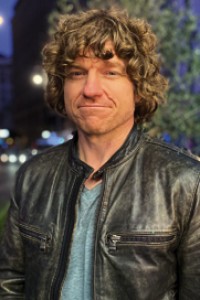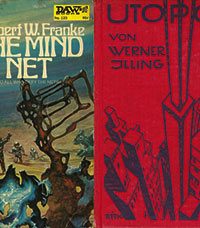Rae Carson: Amulet of Power
 Rae Dawn Carson was born August 17, 1973 in Oakland CA. She attended Livermore High School and graduated from Biola University in La Mirada CA in 1995. She worked in food service, retail, teaching, and architecture, among other professions. Her last job before becoming a full-time writer was working for the president of Ohio State University.
Rae Dawn Carson was born August 17, 1973 in Oakland CA. She attended Livermore High School and graduated from Biola University in La Mirada CA in 1995. She worked in food service, retail, teaching, and architecture, among other professions. Her last job before becoming a full-time writer was working for the president of Ohio State University.
Carson became active in the science fiction field when she joined the Online Writers Workshop (OWW) in 2004, where she met a number of up-and-coming writers, including her future husband, author Charles Coleman Finlay. She began publishing with short story ‘‘First Waltz’’ in 2006 (as Rae Dawn Carson), and has since published a handful of stories.
Her first novel, YA fantasy The Girl of Fire and Thorns, was published in 2011 (as Fire and Thorns in the UK), and was a nominee for the Andre Norton Award and the William C. Morris YA Debut Award. It began the Fire and Thorns trilogy, which will continue with Crown of Embers (in September 2012) and The Bitter Kingdom (forthcoming in 2013). She recently sold a new romantic fantasy trilogy set during the American gold rush.
In 2007 she married Finlay and moved from California to live with him and her two stepsons in Columbus OH.
Excerpts from the interview:
‘‘I always knew I wanted to write. Since I was a very little girl, I’ve been making up stories. The early ones were mostly about little girls running away from strict parents – I’m sure a psychiatrist would have a lot of fun with that. I would tell my parents, ‘I want to be a writer.’ They were very encouraging, but they would always say, ‘You have to have a Plan B.’ So I worked hard on Plan B for a long time. I’m really lucky that a couple of years ago, Plan A worked out!”
…
 ‘‘By then I had gone through a lot of life changes, so I had different things I needed to say. That’s when I started The Girl of Fire and Thorns. I set out to play fast and loose with some genre tropes – that’s one of the things about me that had changed. I grew up loving the genre tropes. When I was four years old in 1977, I saw Star Wars, and it blew me away! I knew the Force was strong within me, I knew that Luke Skywalker was going to be mine forever, and I knew I wanted more stories about farm boys with epic destinies, and powers and mages and magic. I just loved that, and I sought out those stories for a long time. But by the time I got out of college, those stories started to fall a little flat. …
‘‘By then I had gone through a lot of life changes, so I had different things I needed to say. That’s when I started The Girl of Fire and Thorns. I set out to play fast and loose with some genre tropes – that’s one of the things about me that had changed. I grew up loving the genre tropes. When I was four years old in 1977, I saw Star Wars, and it blew me away! I knew the Force was strong within me, I knew that Luke Skywalker was going to be mine forever, and I knew I wanted more stories about farm boys with epic destinies, and powers and mages and magic. I just loved that, and I sought out those stories for a long time. But by the time I got out of college, those stories started to fall a little flat. …
‘‘Another trope I wanted to play with was the Amulet of Power: the One Ring, the Elf Stone, or whatever. I had just gotten my belly button pierced, and I thought, ‘You know what would be the worst idea ever? Magic navel bling!’ And once I thought of that image, I couldn’t let it go. I deliberately set out to find the most ridiculous Amulet of Power I could think of, and make a story out of it. (I wanted to have a lot of fun.) The working title of the book was Elisa’s Belly. I wanted to keep the theme strong in my head, and always remember to try to have a sense of humor, even as the character went through some pretty serious stuff. …
‘‘I drew a lot on my own experience as a teen. Teens are so self-conscious! It’s part of growing-up: you have this burgeoning awareness of yourself in the eyes of others as you form your own identity, and the result is thoughts like, ‘Oh my God, people might notice!’ That’s the sum of their experience to date, so it feels like reality. When you think people are staring at you, for whatever reason, they’re probably not. But teenagers do have enough brutal moments that they seem justified in feeling bad about themselves. Like the time in seventh grade when some boys surrounded me and taunted me with ‘‘Pizza face!’’ (Yes, I had bad acne.) So with that kind of thing in mind, I wrote a moment in the book where a little boy proclaims Elisa’s corpulence to the world. …
‘‘I have had some feedback from readers who felt the book was preachy. I’m an atheist, but this novel takes place in a pre-industrial society, so it made sense to have a strong religious element. I’m not trying to talk about the value of faith, because I actually don’t believe in that. I did work to get inside the head of a person of faith. I grew up with a fundamentalist Christian background, so I definitely have things to say about God and religion. It’s going to take three books to get there.
‘‘I haven’t seen a lot of religion in literature, especially in young-adult novels, but we live in a country where 83% of citizens (the vast majority) are monotheists, and there are so many different types of belief! So it seems to me that would be an important part of the coming-of-age experience: deciding ‘What do I believe about God, and about religion?’ I see churches on every corner, and it’s on TV all the time; I just don’t see it in young-adult fiction very often, so I wanted to put it there. And it’s terrifying, because of the social pressure. I’ve talked to a lot of teens who have serious doubts about what they’ve been raised with but who don’t say anything because they fear becoming social pariahs – because of what their families will say or their friends at church will say.”
…
‘‘So many ideas, so little time! I just have to be very strategic and focused about what I work on, and I should have a lot of books in me. After the trilogy, I think I’m done with this world. In order to stay creatively fresh, I’ll have to do something else. If I ever start churning out endless sequels because of reader demand, I’ll be grateful to my readers but really sad as a writer. I also have more epic-fantasy books in me, so if ‘my audience demands’ that I write epic fantasy (one can only hope that I have such an audience), it would be a different world, and a different set of characters.”





